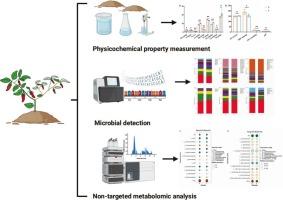Waterlogging disrupts soil-microbe-metabolite interactions in the pepper rhizosphere, driving wilt disease emergence
IF 5
2区 农林科学
Q1 SOIL SCIENCE
引用次数: 0
Abstract
The phenomenon of pepper wilt has increasingly emerged as a significant factor contributing to yield reduction; however, a clear understanding of its underlying causes remains elusive. Inter-root microorganisms can influence plant growth by facilitating the transport of foreign substances into the plant through various mechanisms. We aimed to explore the key microbial factors affecting pepper wilt by analyzing pepper inter-root soils. We conducted a comprehensive analysis of soils from healthy and wilt-affected pepper regions, evaluating their physicochemical properties, microbiome composition, and metabolomics. Healthy soils were found to have higher magnesium, iron, potassium, microbial carbon, and cation exchange capacity. Microbiome sequencing showed that healthy soils were dominated by PTLA13, Lysobacter, Sphingomonas, Pseudomonas, Mortierella, Bionectriaceae, Sordariales, and Onygenaceae, which were more prevalent in healthy regions, whereas A4b_norank and Agaricales fungi were more commonplace in wilted regions. Metabolomics revealed GL glycerides in wilted regions and lignans and coumarins in healthy ones. We suggest that the combined effects of changes in soil physical and chemical properties, shifts in unique microbial communities, organisms, and variations in the increase or decrease in metabolite concentrations collectively impact the health of the microecology surrounding the pepper inter-root. These interactions may trigger abnormal plant growth responses to external stressors, potentially increasing the incidence of pepper wilt in subsequent years.

涝渍破坏了辣椒根际土壤-微生物-代谢物的相互作用,导致了枯萎病的出现
辣椒萎蔫病日益成为导致产量下降的重要因素;然而,对其根本原因的清晰理解仍然难以捉摸。根间微生物通过多种机制促进外来物质进入植物体内,从而影响植物生长。通过对辣椒根际土壤的分析,探讨影响辣椒枯萎病的关键微生物因素。我们对辣椒健康区和枯萎区土壤进行了综合分析,评估了它们的理化性质、微生物组成和代谢组学。健康土壤具有较高的镁、铁、钾、微生物碳和阳离子交换能力。微生物组测序结果显示,健康地区土壤以PTLA13、Lysobacter、Sphingomonas、Pseudomonas、Mortierella、Bionectriaceae、Sordariales和Onygenaceae真菌为主,而干旱地区以A4b_norank和Agaricales真菌为主。代谢组学显示萎蔫区有GL甘油三酯,健康区有木脂素和香豆素。研究表明,土壤理化性质的变化、独特微生物群落的变化以及代谢物浓度的增减变化共同影响着辣椒根间周围微生态的健康。这些相互作用可能引发植物对外部胁迫的异常生长反应,潜在地增加随后几年辣椒枯萎病的发病率。
本文章由计算机程序翻译,如有差异,请以英文原文为准。
求助全文
约1分钟内获得全文
求助全文
来源期刊

Applied Soil Ecology
农林科学-土壤科学
CiteScore
9.70
自引率
4.20%
发文量
363
审稿时长
5.3 months
期刊介绍:
Applied Soil Ecology addresses the role of soil organisms and their interactions in relation to: sustainability and productivity, nutrient cycling and other soil processes, the maintenance of soil functions, the impact of human activities on soil ecosystems and bio(techno)logical control of soil-inhabiting pests, diseases and weeds.
 求助内容:
求助内容: 应助结果提醒方式:
应助结果提醒方式:


